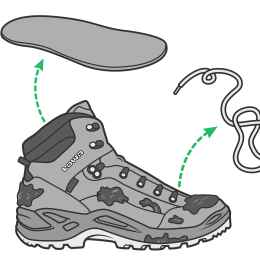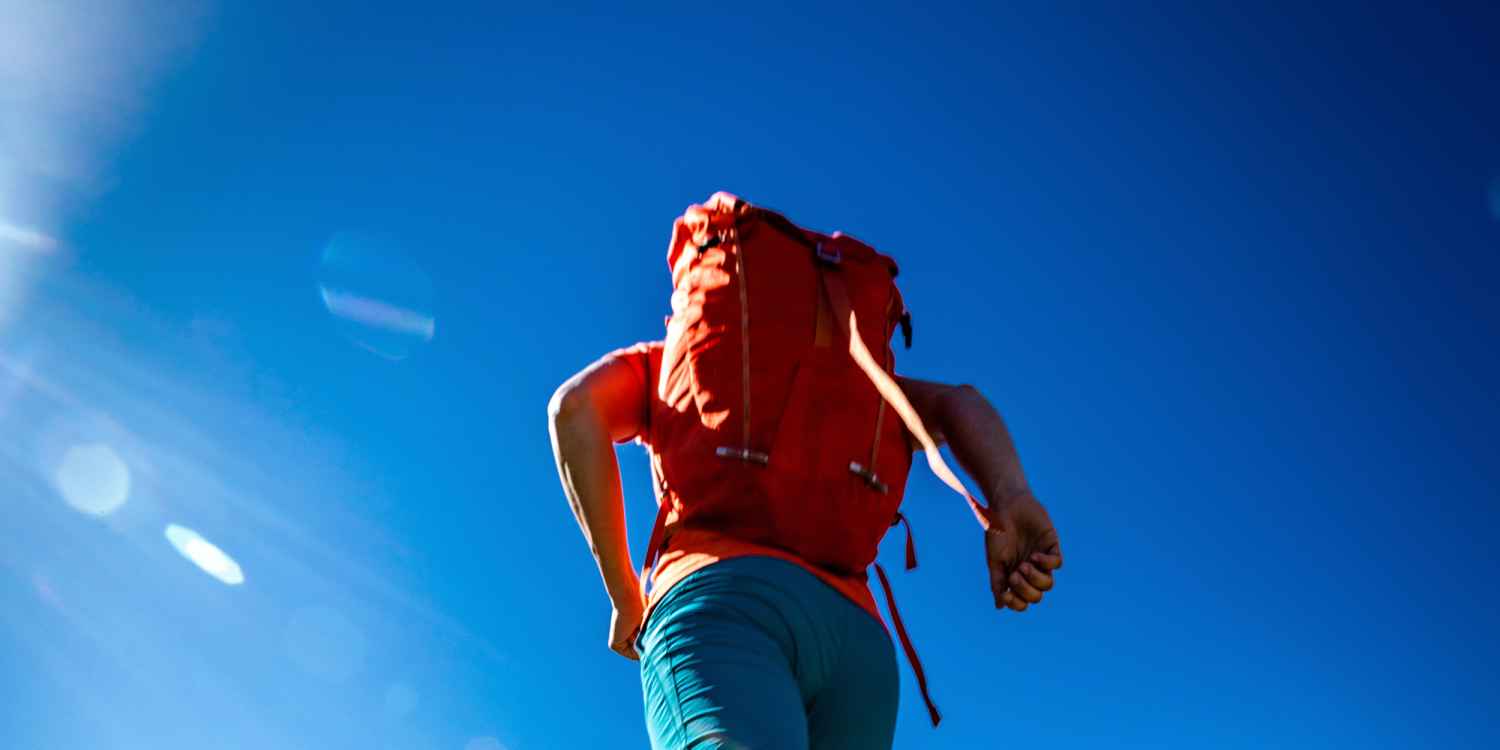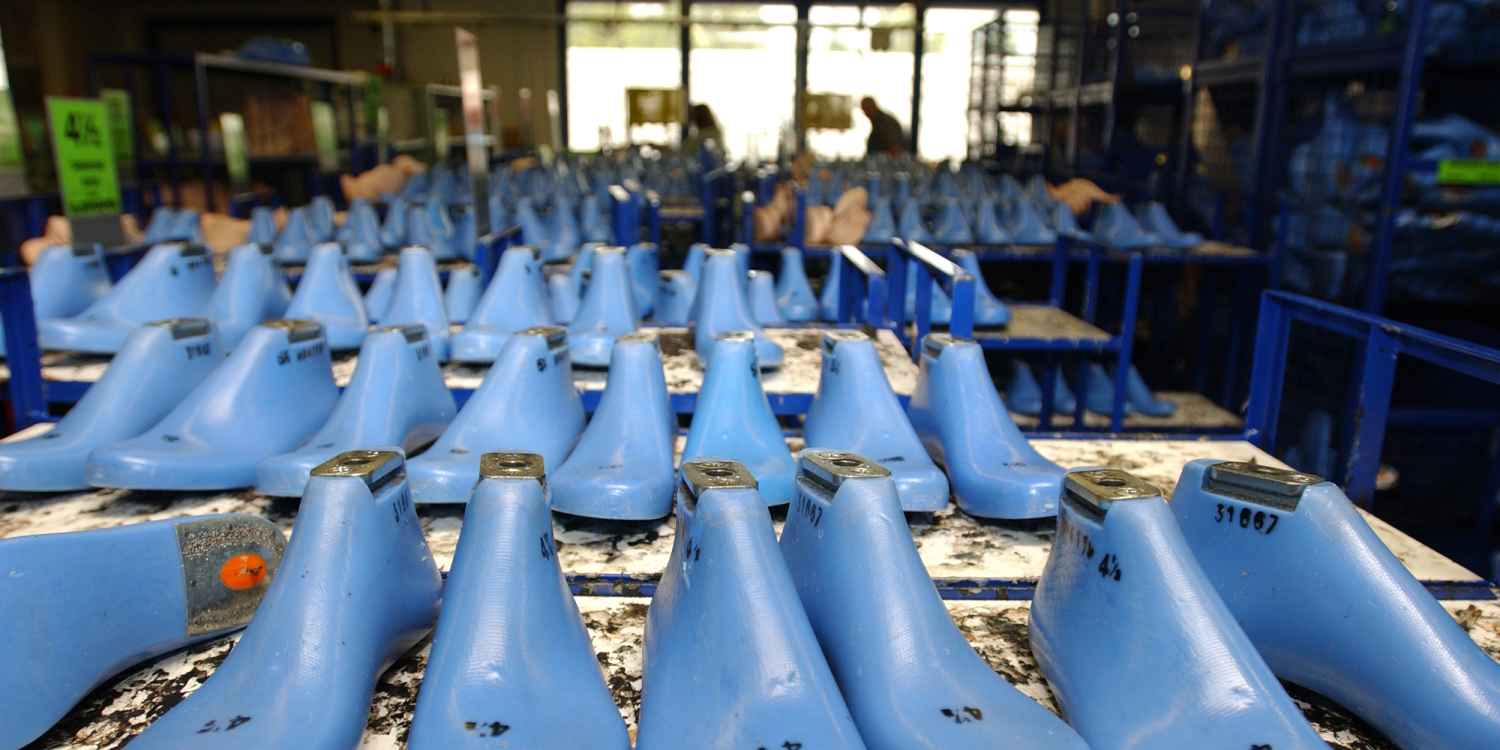
“Your best bet is to try shoes on during the afternoon, as your feet swell a little during the course of the day.”
— Arthur | LOWA Manager Service Department

There are numerous myths surrounding the proper and necessary care of hiking shoes. We have summarised here what is really important and what are the common fallacies.


Our shoe tip:
LOWA PFLEGEBÜRSTE
Model for Women and Men

Our shoe tip:
ACTIVE CREME 75ml
Model for Women and Men
Good care will keep your shoes comfortable and water repellent for a long time. The following tips are designed for all LOWA models made of smooth, nubuck and split (suede) leather. To make sure that the leather stays this way and that you enjoy your high-quality boots for many years to come, you need to care for them regularly. New boots require no additional care before you wear them for the first time, but they will benefit from regular leather conditioning treatments.

Preparation
If your boots have become wet or dirty, allow them to air dry in a well-ventilated room. Do not place your boots near any heat source, which can cause the leather to shrink and crack. Remove the laces, which will help the leather care products reach the recessed areas of the boots, and remove the insole. Removing the insole is very important, particularly after a multi-day hike, since moisture tends to collect under the insole.

Cleaning
Thoroughly brush off your boots. This will help make the leather breathable once again. Then clean the boots with warm water and a brush. If your boots are very dirty, you should use a lukewarm soap solution (e.g. LOWA Shoe Clean) or a boot care product, which will open the pores of the leather, and then thoroughly rinse the boots. The leather is now in an unprotected condition: It will immediately absorb any water that comes in contact with it. You will need to treat the boots after drying with a waterproofing agent after this step.
Take care when drying your boots: Let them air dry in a well-ventilated room. You should never dry them in the sun, in a bathroom, next to a heating unit, in an oven or in a hot car, as wet leather can “burn”, becoming brittle and prone to shrinking and cracking. Conversely, your boots can develop mildew if you store them in a damp area.

Waterproofing
Your boots should be slightly damp when you apply waterproofing spray (e.g. LOWA Water Stop PRO). The pores of damp leather are wide open, enabling the waterproofing spray to penetrate deeply into the material. The spray reaches its greatest level of effectiveness after 24 hours – at that point, your boots will then be water- and dirt-repellent once again. Regular waterproofing treatments will repel water and dirt. The breathability of the leather will be maintained, but the leather will not absorb water and it will be water repellent, making the boots completely protected. You should treat your boots once again before you set off on your next outing. (The spray’s effect begins to wear off after about three weeks.)

Care
If you wear your boots frequently and often get them wet, you should use a boot-care product on them, even on boots with GORE-TEX linings. Poorly maintained leather dries out, becomes brittle and cracks, and ultimately, the boots will become irreparably damaged. Apply a waxy shoe paste (e.g. LOWA Active Cream) or cream with a soft brush (LOWA Shoe Care Brush), and give your boots enough time to dry out. You should treat your boots once again before your next trip. Do not use any pure oils or fats on your boots. These treatments may indeed make the leather very soft and nearly waterproof – but they also close the pores of the leather, causing boots to lose their stability and breathability. These oils or fats can also loosen the adhesives used to bond the boots’ soles to the uppers.
A note about nubuck and split (suede) leather: The surface of these types of leather will become smoother, shinier and darker when wax is applied to them. The surface of suede leather can be brushed out with a suede brush (e.g. LOWA Triangle Brush), but the original look will suffer to a certain degree.

Storage
Store your shoes in a shoe bag or box in a dry, well-ventilated place. Use a wooden shoe tree to maintain your boots’ form. It will preserve the boots’ shape and prevent creases from forming. As an alternative, you can stuff crumpled newspaper in the toe of the boots. The paper will absorb moisture and help preserve the shape of the boot. Change the paper every day until the boots are dry.
If you sweat profusely, a special leather-care lotion should be applied from time to time to leather linings because the salty sweat produced by your feet can dry out the leather, making it brittle and hard. GORE-TEX linings require no special care, but they can be cleaned occasionally with lukewarm water and a gentle soap solution. Also, please regularly clean and condition the leather on GORE-TEX boots as the GORE-TEX membrane will lose its effectiveness if you do not keep the leather uppers in good condition. It is not enough to apply waterproofing or shoe-care spray to intensively used GORE-TEX shoes!


Our shoe tip:
LOWA PFLEGEBÜRSTE
Model for Women and Men
A big myth is that GORE-TEX shoes do not need to be maintained. The waterproof, breathable GORE-TEX lining is located on the inside of the shoe, so it has nothing to do with the outer care of the leather or synthetic material. That means: even a GORE-TEX shoe needs to be regularly cleaned, cared for and waterproofed according to what the material of the upper requires. And the GORE-TEX lining is also happy about washing with a little shoe cleaning agent and a soft brush.
All adhesive board-lasted shoes in LOWA’s TREKKING and MOUNTAINEERING categories can be resoled. Whether this makes sense or not depends on the condition of the shoes. Age does not play a role here. Even very old shoes can be given new soles and fresh anti-gravel protection. However, the leisure and light hiking shoes in the ALL TERRAIN CLASSIC and ALL TERRAIN SPORT categories can’t be completely resoled on account of the way they are made. On these models the sole is sprayed on using a special process and can’t be replaced. However, they can be reheeled. If required, the LOWA Service Team will be pleased to provide advice.

LOWA shoes are designed to be durable and many details can be repaired or replaced. Nevertheless, certain materials have a limited shelf life, e.g. the sole’s impact-absorbing wedge. This synthetic material ages over time and becomes porous at some point. This is a natural wear and tear process. That is why LOWA provides a complete resoling service for its TREKKING and MOUNTAINEERING shoes, which involves entirely replacing both the impact-absorbing wedge and the tread sole, which is subject to wear and tear. Yet even with this kind of makeover, one truth remains: nothing lasts forever.

Be it hiking or walking around town: a good, sturdy pair of outdoor shoes covers a wide range of applications. Nevertheless, each LOWA shoe category has a certain limit and the associated models are not designed to cope with every type of adventure. Safety is the priority here. For example, although the multi-functional shoes in the ALL TERRAIN CLASSIC or ALL TERRAIN SPORT categories are really light, they are not suitable for use on scree or for hiking tours in rough terrain. For optimum protection and satisfactory stability, you are better off opting for a trekking shoe. There is a corresponding shoe for every application.

Even if lengths of a LOWA shoe size are roughly identical, shoes sizes are not standardised. This can result in minor differences in size from category to category and from footwear manufacturer to footwear manufacturer. Furthermore, the shape of the shoe plays an important role in the perception of size. A narrow shape makes the shoe appear smaller, while a wide shape tends to make the shoe appear larger. Of course, your feet also change during the course of your life. As you get older, they get wider and longer. That’s why LOWA recommends you should always try on shoes and check your size in the shop before you buy them. When trying on shoes at a retailer, you should also remove the inner soles and stand on them. This tells you very quickly whether your feet have enough room. A brief guide is provided by the Table of Shoe Sizes on the website.

“Your best bet is to try shoes on during the afternoon, as your feet swell a little during the course of the day.”
— Arthur | LOWA Manager Service Department


Our shoe tip:
ACTIVE CREME 75ml
Model for Women and Men
Dubbins and oils are clearly not the ideal choice for looking after modern leather shoes. It is generally important that shoes made of leather are cared for regularly, to ensure they remain supple and ready for use over a long period. But there are definitely differences in the choice of care products available. The dubbins and oils that are frequently used are generally unsuitable, as they soften the leather over time and can even seal it completely, so that the shoe can no longer breathe. Any adhesive bonds on the shoe may also be rendered ineffective. You’re better off using special leather wax and impregnation spray. Special leather care products for outdoor shoes, e.g. LOWA Active Creme or LOWA Water Stop PRO, are available from specialist retailers.

“Do not forget textile materials! You should also regularly waterproof the textile materials on your boots in order to improve the material’s ability to repel water and dirt.”
— Arthur | LOWA Manager Service Department

The misconception that every outdoor shoe is automatically waterproof is unfortunately widespread. Yet the various models differ very considerably in terms of design and materials. For example, a shoe with leather lining exploits its strengths in warm and dry conditions to the full. The leather lining can absorb plenty of moisture (sweat), cools slightly and is a perfect fit with the foot. These shoes defy moist conditions for a certain period of time. However, this lining is not waterproof and also requires a certain time to dry. In contrast, shoes with GORE-TEX lining are waterproof and therefore very suitable for use in wet conditions – in particular over a longer time period. Which shoe is the right one for whom depends on intended purpose and personal preferences.

You should never put leather or synthetic footwear in a washing machine. The mechanical effect of the washing process in combination with the increased water temperature can wash out leather pigments, damage the upper materials and loosen adhesives. Your boots could suffer irreparable damage.

Acid, petrol and manure can attack the materials used in the soles of boots and adhesives, and can set in motion a process of deterioration that can damage your LOWA boots. Try to avoid these substances and thoroughly clean your boots if they do come in contact with them.